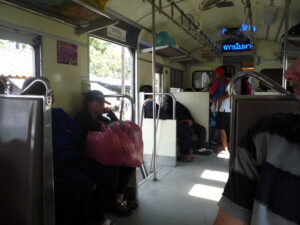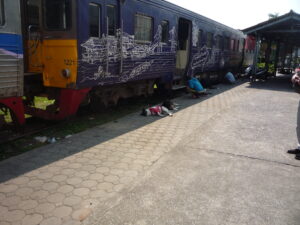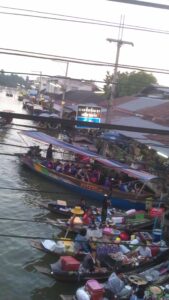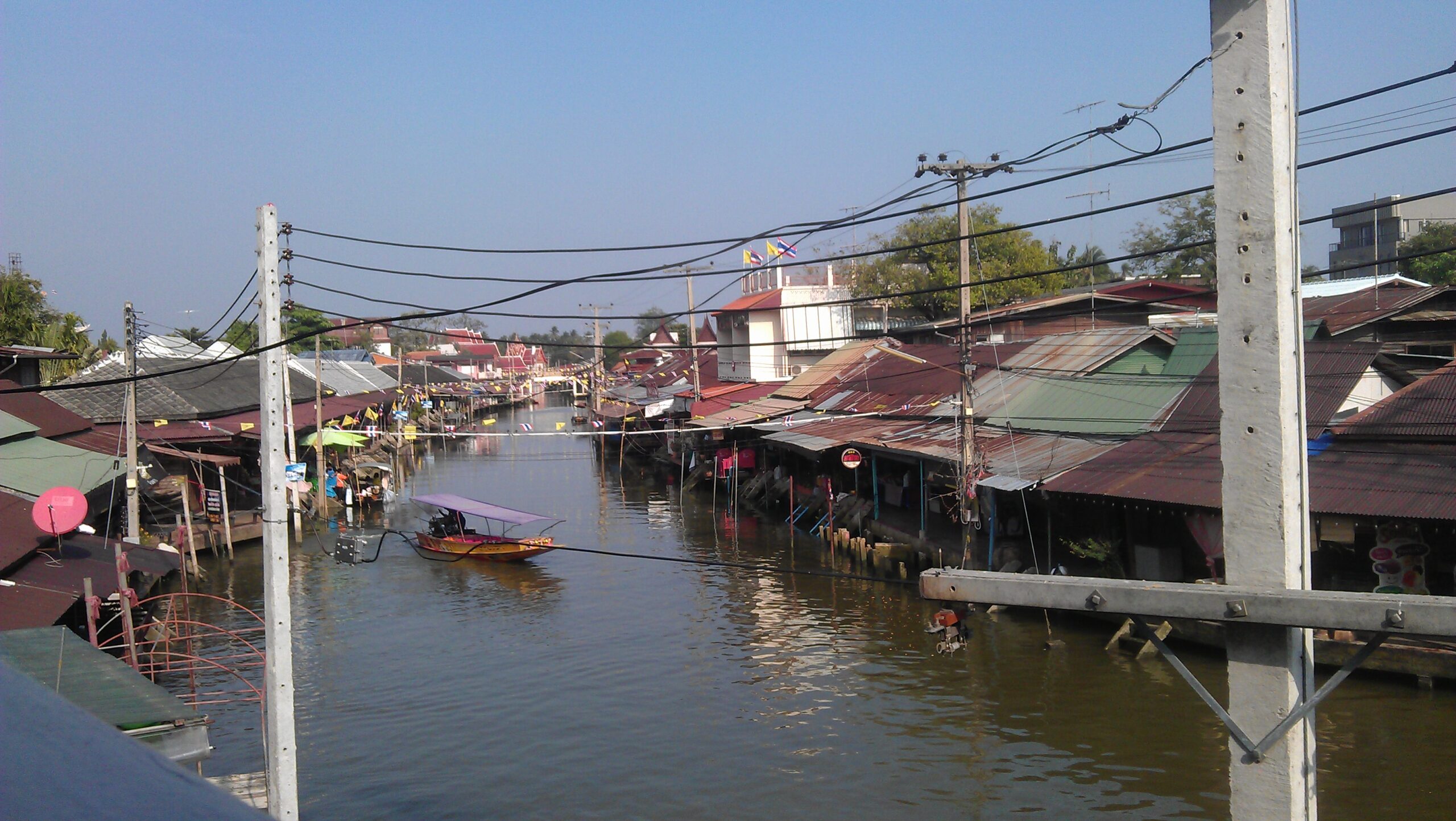December 21st, 2013, writing at San Sook Guestplace, Ayuthaya.
In this economy, it’s all about “experiences” and less about goods. These are not my words, but those of a close personal friend and entrepreneur. I believe he is right. We love, live by and are constantly seeking trusted and new experiences alike. One recent experience during my trip to Thailand gave me first hand insight in the art of crafting the perfect experience: the Amphawa floating market near Mae Klong (Samut Songkram).
The ease and fluency with which the Thai are masters at giving you the right experience at the time and, more importantly, at the right price is just amazing. Althoug part of the same experience, I’m not talking about the usual Thai eloquence with which each hostel owner seemingly is aware of the degree of occupation at every other place in town –fully booked except for his place- or the ostensibly retired government worker who wants to help you in Bangkok with finding the right place by placing you on a Tuk Tuk to a Reservation Center at the outskirts of town.
I am talking about the Thai Railways station supervisor who holds up an entire train to allow you to get at your cup of noodles, made at the local food stands and skillfully packed to enjoy a small meal on the three hour train journey. Or entering a Guesthouse, being welcomed by the Lady of the House with a smile and a hot cup of coffee –at no extra charge-, before being shown the rooms. Or the random motorcycle driver who stops to help you understanding the symbolic but ever so wrongly scaled and ignorant city maps who assist little if at all when explaining the locals where you want to go.

Taking the train from Bangkok to Mae Klong must be part of the Walhalla of every discoverer alias backpacker to get the authentic experience. After taking a cab to Wongwian Yai Train Station, the journey really starts once you step on a Japanese second-hand train, standing in the middle of a respectable and orderly organized street market. With seats as rectangular as they today still are being designed for certain Japanese High Speed trains, this train is bound to take you slowly out of the highs and lows of Bangkok. As the numbness of the seat sets in, the shabby constructions, makeshift markets, the occasional howling dog along the despicable Bangkok alley makes place for a view over fields filled with water dotted with industrial development, distant highways and rice plantations.
After one hour and a half I scramble to get my backpack and, not finding any latin characters, rush to get off the train before it enters its depot. Finding the boat service which will take me from one side of the river to the other seems harder than I ever imagined it to be. Descending from the train at Mahachai station, I peer above the little stalls to find an exit to this densely filled market, alias train station. I make it to the city market and turn right, only to find a street packed with stalls, local shops and the occasional pharmacy.
It’s just before midday and the village is enjoying gracefully the chaotic positive energy of its habitants. The mood is festive; the environment suffocating for the packing smell of food stalls is mingled with the peculiar smell of dried fish. Mahachai market is one of the oldest fresh seafood markets.

After some searching I reach the boat service and, relying on common understanding as no common language is at hand, I pay the 3 Bhat to get on the boat. Once arrived on the other side of the Chin River, Bam Laem seems, in comparison with MahaChai (market), desolate with more stray dogs on the street than cars. Luckily there is a 7/11 on Main Street, giving me an opportunity to procure my lunch. Turning to the right, I start my walk to the station to continue our voyage to Mae Klong. Walking past a huge temple, next across an elementary school, I cross rails which cannot hide this line has been in operation since 1902.
Initially to transport fish to Bangkok markets, the rail today transports mainly passengers. At the end of the Train Line I find the Bam Lean train station, where the Station Master and the ticket officer stare at two stray dogs that are vastly asleep and a number of railway mechanics whistling while they fix a blue railway carriage. I’ve arrived too early.
The adventure continues as we get on the train to MaeKlong. Well into this second ride of the train, the train manager falls asleep. Little later I notice the water, until then just below rail-level, now seems to be higher than the rails. Suddenly the train manager wakes up and calls me. This must be the main attraction of this trip, as I am allowed in the driver’s cabin to take picture of how the train drives through the water.
Moments later I witness how we enter a market, where the shop fronts and awnings are moved back to allow the train to pass. As soon as the train has passed, merchants put back their goods and continue to trade, hindered only by small troops of Japanese and Chinese tourists.
Amphawa is being touted as one of the last places where authentic Thai riverside living can still be observed. The intricate network of lakes and flows are all connected with the ocean, causing a peculiar situation in which salt water enters with high tide and fresh water leaves when low tide sets in. This has allowed for a special way of living, in which every family has a boat to fulfill the majority of daily tasks and were able to fulfill in their needs.
To get to Amphawa I need to take a Songthaew first. Finding the Bus Station in MaeKlong (Samut Songkram), or more specific, the spot where Songthaews of all kinds find somehow their customers, is difficult if not impossible. Our Travel Guide points to the North, while somehow everybody in this little town seems to direct me to different places. After a good amount of searching, I notice a Songthaew with a couple Asian, but not Thai faces. “Amphawa?”, they yell. I climb on the little open van and push unwillingly some 10 year old Thai schoolboys of the van. The advantage of being big and white.
With us on the Songthaew are 5 Chinese travelers visiting Amphawa. They seem to be happy to see some western faces and start a conversation in English. Not really fluent, but they are certainly more talkative than the quiet stares from the Thai on the Songthaew and certainly informative. Together we jump of the van and without hesitation one of the Chinese interprets the little map next to the makeshift stop. Apparently they do understand the Thai way of interpreting city maps.
We scroll together to the Amphawa market and, before they realize it, they are being sold a 1000 Bhat hour tour of the old market. The well-built Chinese youngster asks the boat tour vendor if they get to see any real market on the tour. She answers fluently but with a more subtle voice that trading is only done in the morning. We look a tad surprised, as our guidebooks indicate the “real” market is about to start now. Of course, little did we know there is more than one type of market.
It’s Friday 4pm and buses full of Japanese and Chinese enter the parking at the back of the market. The sky is still clear although the sun is gradually showing its eagerness to end the day gracefully. Stands with food, desserts, fruit and memorabilia fill the small streets around the canal and the vendors are at their best.
Food stands are to be found on the boats, while the tables are on the docks or the steps leading to the pathway. The smell is seducing, the produce fresh and the price great. Three hours later, loaded with a memory of the one hour tour of the market and its surroundings, the taste of some fresh Thai seafood and the sweet impression of colorful Thai desserts, many tourists get back on the bus and leave for their next stop.
I observe the tourists that chose the fast way into town and were content to have found the authentic sensation of true Thailand. Among these Asian visitors I notice some well-of Thai, just to be overwhelmed by Chinese, Malaysian and even Japanese nationals absorbing the distilled fragrance of authenticity. A visiting French couple seemed unimpressed and told me they were a bit disappointed. No authenticity, little to offer and, as they confessed to me, they expected something more, perhaps something bigger. They, however, did not choose to stay the night at the Amphawa market.

My experience is more positive. An extensive walk culminates at the docks next to one of the two bridges of the Amphawa market. When I sit down to eat at only a foot away from the green-grey water, I hestitate to order but then, convinced by the smile of a young Thai girl handing out the menu, continue to order some squid, shrimps and rice. To my surprise, the presentation of my food, the wooden sticks that accompanied the meal and the form of the plates remind me more of my recent travels to Taiwan and the stories of my sister on Chinese food than the Thai food I had eaten until then. The taste however is priceless, authentic and truly Thai. Fresh seafood, sometimes hard to find even at home living 20 minutes from the coast, was here readily available, cooked before my eyes in open boats and spiced by “la mamma” herself.
8pm and the first stalls close down with a certain confidence. Not soon after the first shops at the riverside dim their light, souvenirs are being covered or locked away while the floating boats which cater to the ad hoc riverside food corners float away into the distance. As I walk to the Guesthouse, I notice how new every building is. I’m particularly impressed with the stylish renovation of the Rimrabeang Guesthouse, which for its style is worth only the most exigent tourists. We share this house with Japanese tourists. Adjacent to the guest house is a coffee and ice cream parlor.
All day long Asian tourists of different nationalities stopped to take pictures of the Guesthouse Sign with a bicycle next to it. Sitting down for a coffee I realize this place must be famous, but till today I do not know why. All houses have been renovated and only occasionally, behind the tourist stalls, one can see a convenience store Thai style. This market ought to generate an additional 500 USD for each household in the region, hence its importance and economic driver for the community.
Indeed, the real story of Amphawa is different and often neglected. It is the authentic way of life of the people around the canals in the region that is considered heritage. People having a boat to travel and transport goods over water from one place to another and, why not, trade goods from place to place. It’s about the ecosystem -or what is left- stemming from a unique symbiosis of water based settlement and its architecture.
This way of life exists and is still part of the daily reality of many people. It should also be said that Thailand is now as much part of the global village as is every other country in the world. Food comes in from the market and people have options to buy produce from many different outlets. Many, if not every, house on the river is today also connected by road.
The Amphawa market today is a development project. It is a tad touristy. Its target audience is not European nor is it American, which makes it all the more interesting. Thai, Chinese and Japanese spend some time at the market and allow this way a local economy to flourish. This tourism sprung from a local need, that is, to generate honest revenue for the local community.
Amphawa market is an experience and, may I say so, a daringly well constructed one. My stay at the market left me with a lasting impression, especially of the Thai capacity of giving you a true experience, with a smile and a sniff of authenticity. The only danger is, as the construction of a new hotel showed this year, Amphawa might lose its authentic flavor to that of tourism development ventures.
More information and references:
- Mahachai Market: http://www.bangkokpost.com/travel/15536_info_mahachai-market.html
- Amphawa way of life and the Floating Market development : http://openarchive.icomos.org/79/1/77-koba-15.pdf
- On Amphawa development : http://www.travelfish.org/blogs/thailand/2012/08/30/bangkoks-amphawa-what-is-going-on/

Leave a Reply